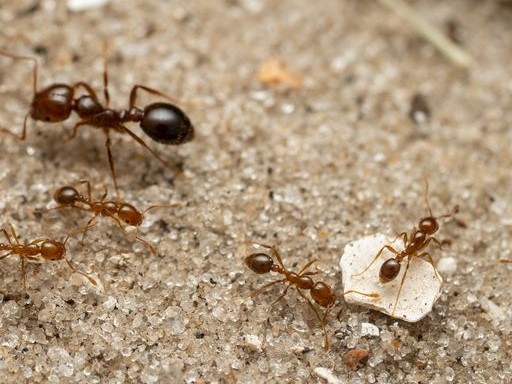Reactions: the fire ant, one of the most invasive species, is already in Europe and may arrive in Spain
One of the world's most invasive species is Solenopsis invicta, an ant native to South America with a painful sting. In an article published in Current Biology, experts confirm the first official sighting of this species in Europe: 88 nests spread over five hectares near Syracuse in Sicily, Italy. The ants could soon spread across the continent, causing serious environmental, health and economic problems. The study is led by the Institute of Evolutionary Biology (IBE) of the CSIC and the UPF.

Joaquín L. Reyes-López - hormiga fuego
Joaquín L. Reyes-López
Full professor of Ecology at the University of Cordoba
The data is clear, convincing and supported by audiovisual material. The great novelty of this research is to confirm the presence of an invasive species that poses a global threat. In areas favourable to their settlement, such as coasts or wetlands, they can cause serious damage to local ecosystems. In addition, they constitute a serious health problem for humans due to their stings.
As regards control of the invasion, the experiments carried out in the USA and Australia have not slowed down its expansion. Biological control is currently being experimented with, looking for natural enemies, such as parasitic flies (Phoridae), among others, to control their populations.
Finally, this species is included in the Spanish Catalogue of Invasive Species and its file can be consulted at the Ministry.
Elena Angulo - hormiga fuego
Elena Angulo Aguado
Researcher at the Doñana Biological Station (CSIC)
The article focuses on describing the detection of the invasion of the fire ant, Solenopsis invicta, in a small area of Sicily, near the port of Syracuse. This would unfortunately be the confirmation of the first establishment of the species in Europe, occurring in a protected area. Previously, it had been detected sporadically elsewhere in Europe, such as in greenhouses or during inspections of imported products in ports.
The fire ant is one of the worst invasive species worldwide. This is mainly because it has a very strong sting, which can cause severe allergic reactions in humans and even death. Where it is established as an invasive alien species, such as in China, the United States or Australia, it has a high impact on health and welfare, as well as on economic sectors such as agriculture. In countries that fear its arrival, such as Japan or other Pacific countries, millions of euros are spent on its prevention. It is therefore a priority for Italy (and Europe) to carry out an early eradication of the species in the Syracuse area, whatever the cost; because if successful, it would save the country serious health and economic problems.
This study suggests that half of Europe's territory, and more specifically large coastal cities with important ports such as Barcelona or Valencia, could be the next entry points of this ant into Europe. Therefore, Spain should now focus on prevention, carefully controlling entry routes into ports, as well as imports susceptible to fire ant contamination, and being prepared for a rapid response. Preventing new entries and possible establishments in Europe is crucial, in order to avoid the socio-economic impacts of uncontrolled spread.
Olivier Blight - hormiga fuego
Olivier Blight
Assistant professor at the Mediterranean Institute of Biodiversity and Marine and Continental Ecology (IMBE) in Avignon (France)
Menchetti and his colleagues have just published in the prestigious journal Current Biology on the first establishment of the fire ant S. invicta in Europe. Genetic analysis of this South American invasive species suggests that it was introduced into Italy from the United States or China.
This species is considered to be one of the worst invasive ant species, with major impacts on biodiversity, health and the economy. This species generates economic costs of several million euros per year, linked to its impacts but also to the costs associated with its management. It is therefore essential to implement preventive measures and raise public awareness about this issue. Since 2022, this species has been on the list of species of Union of concern for Europe, prohibiting its marketing, possession and capture. This regulation also obliges Member States to take action to control or eradicate the species within months of its detection.
This detection of an new invasive ant in Europe is a very good example of the growing problem of biological invasions, which should oblige Member States to equip themselves with regulatory and financial tools to respond effectively.
Luis Calcaterra - hormiga fuego
Luis Calcaterra
Senior Researcher at the Foundation for the Study of Invasive Species (FuEDEI) and the National Council for Scientific and Technical Research (CONICET) in Argentina, and expert on highly invasive ants native to the Rio de la Plata basin
The globalization of trade and travel has led to high worldwide invasion rates. One potential driver of this acceleration is the bridgehead effect, in which initial invasive populations (e.g. USA or China) serve as a source of additional invasions through secondary introductions. Studies of several invasive ant species suggest that invasion success is primarily attributed to populations of a particular genotype (e.g., H5 of S. invicta found in Italy) that is also dominant in its homeland.
Urbanized areas experience higher temperatures than adjacent suburban natural or rural areas. This is known as the urban heat island effect, which is promoting the spread and establishment of invasive species in the native and introduced range.
The red fire ant is the most ecological and behaviourally dominant ant species in its homeland. Introduced populations of S. invicta can reach up to 10 times higher densities than native ant species and thus dominate most potential food sources. Thus, this ant is a potential ecological and economic threat in all areas where climates are natural or artificially suitable, as in big cities, including large portions of Europe.
Gema Trigos Peral - hormiga fuego
Gema Trigos Peral
Researcher at the Department of Social and Myrmecophilous Insects, Museum and Institute of Zoology (Polish Academy of Sciences) in Warsaw, Poland.
From my point of view, the work is of high quality. It is based on clear evidence of the establishment of S. invicta in one where direct sampling has been carried out, which ensures the reliability of the samples. These data are supported by genetic studies, which fit perfectly with the distribution history of this species. In addition, the genetic results show that this is a polygynous population (one nest with several queens), which is the most common structure found in areas invaded by this species.
They use genetics to check the type of nest they have found. The main point here is that if you have more queens per nest, you also have higher brood production and faster colony development. Having one queen is not the same as having several queens laying eggs at the same time. Therefore, the fact that Italian nests are polygynous means that they have the potential to make the colony grow and spread faster, even if they don't make long-distance flights very often.
On the other hand, I do not think that this species is likely to colonise the whole area shown in the article's prediction. There are a number of factors that also determine the success of the species when it arrives in a new area, such as interspecific competition for resources. And to this I would add that it is a species that is mostly distributed in warm areas, corresponding to the temperatures of its area of origin. This same tendency is found in other exotic and/or invasive species also originating from warm areas, such as the Argentine ant, the two species known as crazy ants (Paratechyna longicornis or Nylanderia jaegerskioeldi), the yellow crazy ant (Anoplolepis gracilipes)... all of them distributed mainly in the Mediterranean area. Northern distribution (Belgium, Germany, the Netherlands...) is less likely. Of course, one has to think that the scenario will change with global warming (in Poland it is becoming more noticeable) and the situation described in the article becomes a bit more realistic.
What is carried out is a forecast (based on temperature forecasts and the characteristics of the areas) of the areas likely to be invaded, but it is important to stress that this does not indicate that they will be invaded. The results should be interpreted with caution and with a clear understanding that this is a possibility. As indicated above, there are several factors that will determine whether or not the species becomes established. It is still a prediction based on the suitability of the area, but it does not take into account the biological factors that slow down the expansion of the species: interspecific competition, scarcity of resources, infestations by parasites (fungi, bacteria...). Here the conservation of native species and their habitat plays a very important role. In well-conserved ecosystems with high native biodiversity values, invasive species are less successful in colonisation, as they face more competitors.
Spain would be one of the most affected countries, as is the case with other alien/invasive species. There is a perfect climate and a great variety of habitats (although these ants mostly like areas modified by humans, such as urban and agricultural areas). Already in 2007, it was reported that someone had arrived in Malaga with symptoms of a S. invicta sting. The most important (and dangerous) thing is that I am aware that anthills of this species are being sold in some ant shops among groups of hobbyists. That is the reason why I proposed to create a group to update the list of invasive species in Spain, and one of the proposals was S. invicta. And well, here is the proof that, if they escape from the wonderful anthill we have at home (because they will escape), it is a big risk. I have to say, though, that amateurs are becoming more and more aware of the danger of having alien species, and that is one of the most important steps to curb these problems.
Control of the invasion depends on the state in which it is found. The problem is that by the time it is discovered, the population is already highly developed. Rarely do we notice a single mini-ant in a whole country, but instead we discover many anthills when they start to become a nuisance, as happened in this article. If the population is not yet widespread, it can still be combated by various measures such as removing nests, using pesticides, etc. Lately there has been talk about the possibility of using viruses that are lethal to ants, but of course the consequences are not yet known. This is a fairly new issue. If the population is already widespread, it becomes quite difficult. We have the example of the Argentine ant, Lasius neglectus and S. invicta itself, which have not yet been eradicated in most of the invaded areas.
As indicated in the article, citizen participation is a fundamental ally in the early detection of the problem, which facilitates eradication. And here I would add the importance of raising awareness among hobbyists, as sale is another way for exotic species to arrive. We have around 300 species on the peninsula, all wonderful, all interesting, all unique... you can't love myrmecology if you don't know how to appreciate the diversity you have in front of you.
Menchetti M., Schifani E., Alicata A., Cardador L., Sbrega E., Toro-Delgado E., Vila R.
- Research article
- Peer reviewed
- Observational study
- Animals



